921 Earthquake Museum of Taiwan
At 1:47 in the morning of September 21, 1999, a strong earthquake of 7.3 in the central part of Taiwan occurred, causing casualties and property losses as one of the biggest earthquake disasters in Taiwan in the past 100 years.
To remind the public to pay attention to earthquake prevention and disaster relief measures. After the September 21 earthquake, the government, scholars and experts believed that the faults, the collapse of school buildings, the uplifted riverbeds, and other landforms at the Kuangfu Junior High School Base in Wufeng Township are the best in several candidate locations.
The landform was preserved intact after the earthquake. It is convenient to restore the existing site in the country and plan to rebuild the "Earthquake Memorial Museum" to preserve the original site of the earthquake, record the history of the earthquake, and provide the public and the school's living materials for earthquake education.
It was officially named "921 earthquake museum of Taiwan" on February 13, 2001 to highlight its commemorative and educational significance.
Museum hours are 9:00 am to 5:00 pm
Ticket offices are open from 9:00 am to 4:30 pm
The museum is closed on Monday (except national holidays)
Lunar New Year's Eve
The first day of the Lunar New Year
The necessary closing date for the announcement by the museum.

09:00 - 17:00

09:00 - 17:00

Closed

09:00 - 17:00

09:00 - 17:00

09:00 - 17:00

09:00 - 17:00

| General | NT $50 |
| Group of 20 or more, Students (with valid certificates) | NT $30 |
| Student (6-12 years) | NT $25 |
| Student aged 12 and above with valid student ID | NT $30 |
| Seniors aged 65 and above with certificates (Holidays & Weekends) | NT $25 |

| Children aged under 6 | Free |
| Seniors aged 65 and above (weekdays only) | Free |
| Visitors with Museum Dinosaur Cards | Free |
| Visitors with disabilities and one accompanying person | Free |
Chelungpu Fault ruptured and thrust up when Chi-Chi earthquake occurred. At Kuang-Fu Junior High School, the ground ruptured from the dike along Kan Creek, through the athletic field, school building, and school gate, and along the road towards the north. The fault extends roughly 340 meters across the athletic field and campus.
This gallery seeks to preserve the effects of the earthquake at this site and keep its memory fresh. Real exhibits and interactive displays help the public to learn about earthquake science, personally experience the power of nature, and understand the secrets to maintaining safety in the event of a natural disaster.
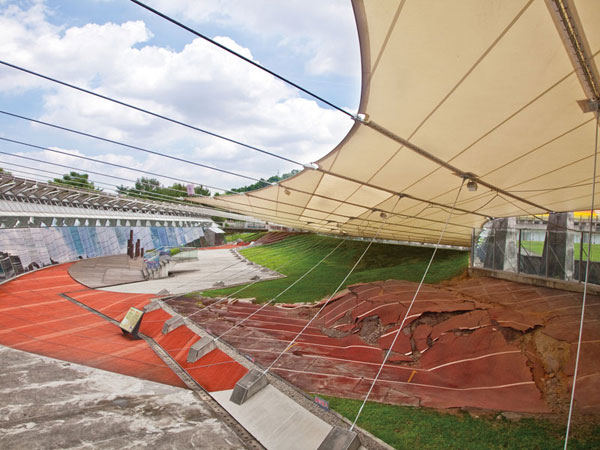
The unique linear design of Chelungpu Fault Gallery resembles a needle and thread stitching up the wound in the earth. The structure also expresses the sequential narrative of Chi-Chi earthquake contained within. This building is not held up by beams and columns. Instead, it is composed of 82 pre-cast concrete plates 12 meters tall, 2.4 meters wide, and weighing 10 tons each. The building has a complex, arched structure. More than a million visitors have toured this building since it was completed on September 21st, 2004.
Earthquake Engineering Hall has been built on the site of a destroyed building at Kuang-Fu Junior High School.
National Center for Research on Earthquake Engineering took part in the planning of this facility, which features a laboratory concept and interactive displays. The exhibition features on three main topics which are home safety, advanced earthquake resistance technology, and public safety. Visitors would then know how to choose or build a safer house. Hands-on architectural models allow visitors to understand earthquake resistance techniques such as seismic energy dissipation devices and seismic isolators.
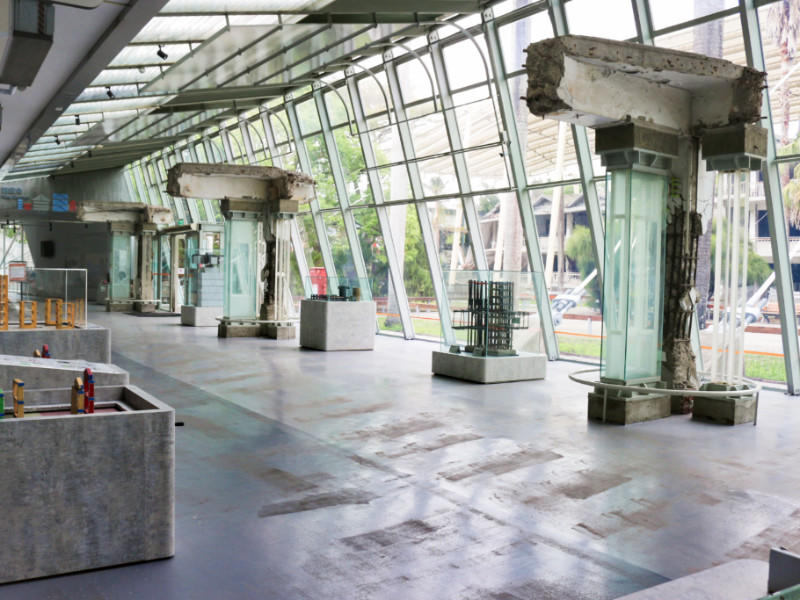
Furthermore, the hall uses preserved damaged classrooms to show visitors the destructive power of earthquake, the typical damage pattern of school buildings and some of the common methods to reinforce structure.
This hall has also designed a unique learning space called Play Corner. It is a fun and vivacious environment for children to learn structure and engineering.
The displays of Earthquake Engineering Hall will increase the public's understanding of architectural seismic damping and protective measures, and inspire visitors to be more aware of safety at home and in public spaces.
Image Gallery used to be the activity center of Kuang-Fu Junior High School. It features photographs and audiovisual materials of Chi-Chi earthquake, and presents the memories of the earthquake pertaining to various aspects of humanities, society, and history.
Through the systematic displays, visitors can get the picture of the impact of the disaster, the rescue and relief efforts, the generosity of society, the rebuilding campaign of communities and schools. Videos and images chronicle how the quake survivors overcome the catastrophe and show their inspiring courage of springing back to life.
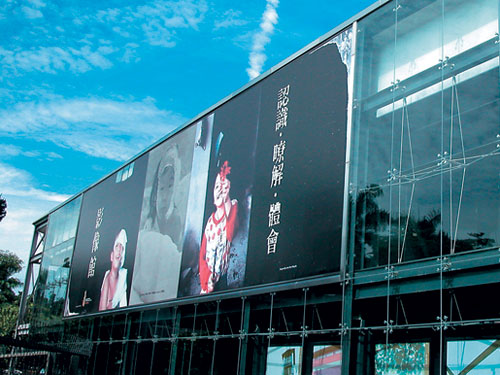
“Earthquake Investigation Bureau”, designed for the first floor of Image Gallery. It provides the Smart Disaster Risk Reduction Experience Zone where visitors can have a good understanding about the integrated application of the Earthquake Early Warning System and the Smart Disaster Risk Prevention Technology by practical operation.
“Earth Theater” and “Earthquake Experience Theater” are two major theaters in the Image Gallery. By enjoying these video materials and personal experiences, people can know more about the importance of environmental education and feel shocked by the simulation.
This hall can help the public to understand hazards and to know how to protect themselves when the disaster happens. There are now two themes on exhibition.
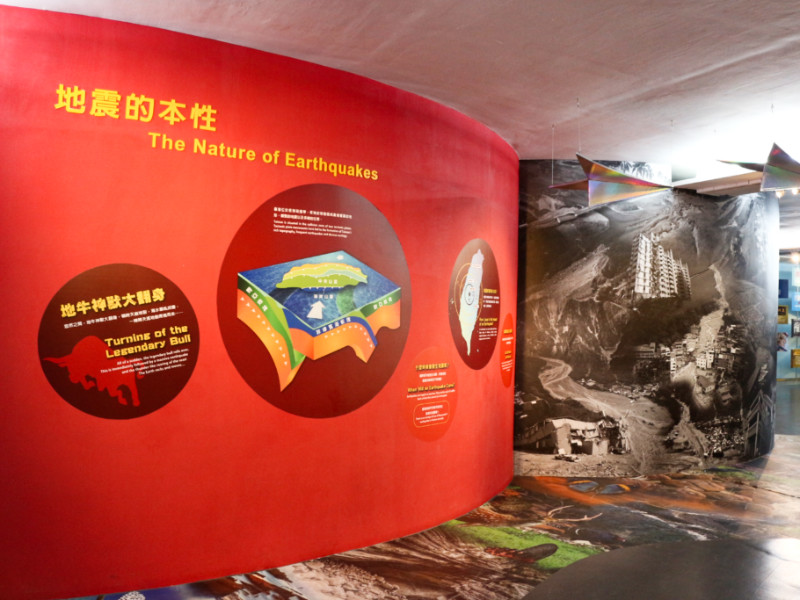
“Flood Tribunal – Flood Prevention under Environmental Changes” opened to the public on the 2nd anniversary of the most disastrous flood that occurred in Taiwan during the past 50 years. The flood itself was caused by the typhoon Morakot, and marked a frustrating defeat despite the gaining efforts to prevent flooding. Other flooding disasters happening all over the world also wreak havoc, raising concerns and discussions for better solutions.
“Magic School of Disaster Preparedness – 921 Earthquake Disaster Preparedness Exhibition” is based on a fictitious school, the Disaster Preparedness School of Magic, including four institutes: Understanding Earthquake, Earthquake Warning, Disaster Response and Disaster Preparedness.
It is expected that through the exhibition in Disaster Prevention Hall can lead the visitors to learn about the cause of flood, tsunami and earthquake, to think about the methods of coexisting with nature, and to care about the significance of earthquake disaster preparedness.
Reconstruction Record Hall documents the reconstruction efforts that have taken place following Chi-Chi earthquake. Admission to this hall is free because it’s been donated by Chi-Chi Earthquake Reconstruction Foundation. Therefore the 10th anniversary of Chi-Chi earthquake exhibits list out five chapters to show how government and civil societies did for disaster relief and reconstruction.
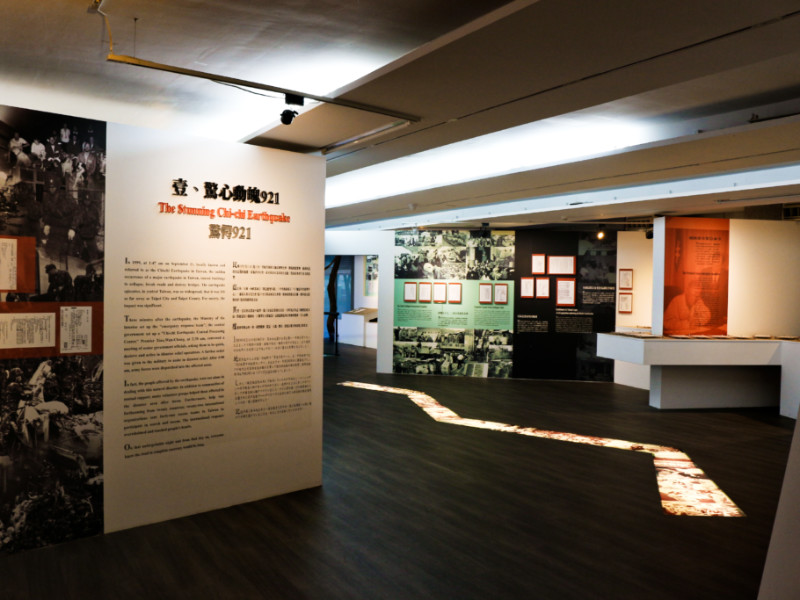
- Chapter 1 The stunning Chi-Chi Earthquake: As a beginning, the designer created a poem, a painting in S. Dalí style and a room simulated as site of Chi-Chi earthquake to interpret the impressions of Chi-Chi Earthquake.
- Chapter 2 Policies and regulations: Taiwan government signed an emergency order to release the limitations of laws.
- Chapter 3 Resettlement: To shelter those survivals, Taiwan government proposed three options which are “temporary housing", "rental subsidies" or "purchase public housing", hence, people could choose one of those to resettlement.
- Chapter 4 Reconstruction: Lots of enthusiastic volunteers participated in the community and school reconstructions.
- Chapter 5 Reflection and Change: After the tragic Chi-Chi Earthquake, the government decided to strengthen national awareness of disaster prevention, improvements in engineering systems and quality by laws and education.
09:15、09:45、10:15、10:45、11:15、11:45
13:15、13:45、14:15、14:45、15:15、15:45、16:15
12:00-13:15 machine is in maintenance and out of service
Limit of 25 people per session, no admission will be allowed after the video starts playing, please to check-in in advance.
Visitors with heart disease, high blood pressure, asthma, epilepsy, spinal injuries, pregnancy and those prone to dizziness are not allowed to participate.
Driving on the National Highway No. 3, exit at 211k Wufeng Interchange, turn right at the end of the exit ramp.
- General vehicles please park in the Parking Lot.
- Wheelchairs and baby strollers please use Disabled Parking.
From the Taichung High Speed Rail Station: take the High Speed Rail shuttle bus No. 151 (Taichung City Council→ Chaoyang University of Technology )and get off at the Kengkou Village(Guangfu Community) stop and walk along Xinsheng Road for 10~15 minutes to reach the museum.
Address: No. 192, Xinsheng Road, Wufeng District, Taichung City, Taiwan.(Google map)
Tel: 886-4-23390906, Fax: 886-4-23397401
Email: 921ser@nmns.edu.tw